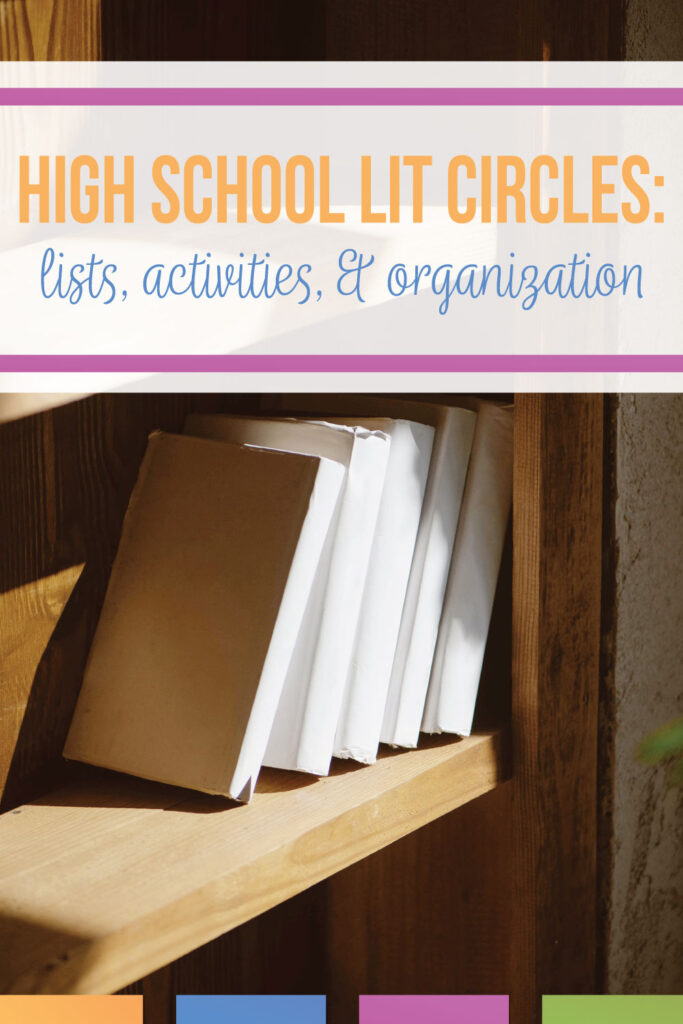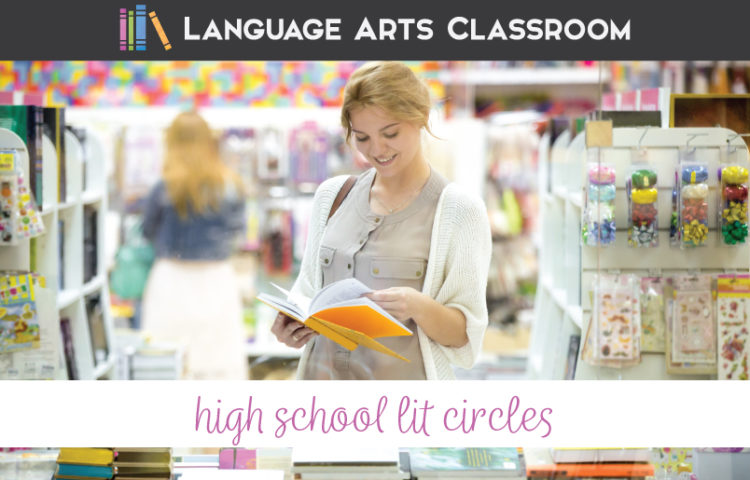Do you know where to start with organizing and planning high school lit circles?
Years ago, I wrote about my experimentation with independent reading and class novels. To me, no matter what I read with students, part of the lessons included giving them tools for life. As we read, I model and say something like: This approach works for me, what will work for you? Let’s figure it out so that you can take that approach and apply it to science class, to your job some day.
Lots of reading with older students includes modeling, and literature circles allow for modeling.
Were you worried about adding circles to your ELA class?
Recently, I’ve added high school lit circles to my language arts repertoire. The discussions we have are amazing, and I can model reading and thinking for students to apply outside the classroom.
Honestly, I avoided trying lit circles for so long because I feared messing up, of implementing them incorrectly. Don’t be like me! Give them a try.
And? I am pretty sure that my methods for organizing lit circles is different than other teachers. For instance, my groups do not have assigned roles when they break into their discussion circles. Overall, find a process that works for you and your classes.
Below are ideas concerning lit circles in high school. Take the ideas that work for you!
Why English teachers like lit circles:
After implementing lit circles a few times in high school English, I continuously see the same benefits:
- Teachers learn about new books. Students and I trade information, and we build relationships through the content.
- Teachers can choose a variety of books for a variety of interests.
- Students take risks with book choices.
- Students are invested in reading.
These benefits arise from other literacy efforts, sure. I still use whole class novels as well as independent reading in class.
Additionally, I share the benefits of lit circles with students when introducing the process. High school students always ask WHY, which shows they are thinking. Explain the benefits of reading and sharing this way.
Possible high school lit circles:
When I add lit circles to a class, I create a theme or choose a genre. I frequently shop for inexpensive books, and lit circles provide me an opportunity to “sell” those books to students. Plus, other ELA teachers and librarians are indespinsible.
When thinking of books for whatever topic or genre, consider:
- What a specific group of students enjoy.
- How much time you have. (Only have a month? Maybe choose a shorter book.)
- What activities will work well. (Research? One pagers? Student built literary analysis? Book-to-move posters?)
- How to implement a variety of experiences, people, and authors.
Then, dive into choosing books for lit circles. Think of how many students you’d like in a group. Four is my sweet spot for a group, but three and five work well too.
Below, are books for common lit circles:
Romance.
To All the Boys I’ve Loved Before
Cool for the Summer
Pride and Prejudice
Frankly in Love
Birthday
Dystopian.
Scythe
Unwind (I know, I know—same author! Both are so good!)
1984
Divergent
Delirium
Red Queen
Uglies
The Darkest Minds
The Grace Year
Mystery.
When
One of Us Is Lying
We Were Liars
Monday’s Not Coming
The Girl in the Blue Coat
I Am the Cheese
The Strange Case of Dr. Jekyll and Mr. Hyde
Any Stephen King!
From those lists, you can see books that span different time periods. Other high school lit circles could include from book to movie; an American or British time period; or award winners like the Nobel.
As I divide book for lit circles, I attempt to throw in a one “classic.” Some students want to read classics, and if they are devoted to that goal, I help them.
Over time, you will continue to add books for lit circles. A simple Google Form works for students to choose their books. Students know that they’ll be discussing the specific book with a small group, and oftentimes, friends will choose a book to read together.
After you decide what books to present to your students, you’ll next decide how you are going to run the lit circles.
Possible activities for lit circle discussions:
I largely ask students for input considering the activities that I complete with literature circles.
My goal in doing so revolves around students’ ages. Since students are older, they will soon be reading without supervision—completely independent readers. How they choose to digest stories will be their choice.
Student-generated.
Some teachers ask students to generate a list of discussion questions. Students might have assigned roles in the lit circle (commentator, literary luminary, summarizer, vocabulary enricher), and those roles will play a part in what students study.
Other teachers give specific questions for the novel (like book club questions) and have students discuss those. The teacher then circles the room and emphasizes certain points, almost as a discussion director.
Topic-specific.
I have also seen teachers give very general questions that work well for any book. Questions might include:
- What is the author’s tone during the first chapters of the book? Provide specific quotations for support.
- Is a possible theme emerging?
- Are conflicts evident yet? Explain how these conflicts might be shaping the story’s theme.
These questions will work with any book, and then after students discuss them for their specific books, teachers can open up the conversation to the entire class. These discussions then lead into “formulas” in books and similarities in genres.
Of course, you can use a variety of approaches when conducting high school lit circles. You can also ask each student to arrive with one question for the group, compile the questions, and focus on those questions for the day.
Genre-specific.
Critical thinking can occur whilst discussing literary elements from a genre-specific view. First, be sure students understand the genre, its definition, and its features. If a book overlaps several genres, get messy with group discussions!
All readers see different aspects of a book. What is primarily a mystery to one student might be a coming-of-age book to another student. Discussing genres is an approach to diving deep with no clear answers.
Remind readers that as lifelong learners, they will discuss reading material in various groups. Examining the attributes of certain genres is applicable to future scenarios.

Vocabulary.
A recent addition to literature circles is the study of vocabulary. For high school students, this can be done in a fun and engaging way. Provide students with a list of challenging words from the book they are reading, and ask them to create their own definitions based on context clues.
During the next discussion, students can share their definitions and discuss any discrepancies or different interpretations. This not only helps students expand their vocabulary, but also encourages critical thinking and analysis of the text. Provide the correct definitions, or review together.
If you would prefer to have readers find their own words, bookmarks work nicely in high school lit circles. While reading, group members write down unfamiliar words. Gather the bookmarks at the start of class, get readers working in groups, and compile the words. Return the bookmarks, and share out the word lists.
I have found that older students do not mind word walls. As an extension activity, provide a frame to everyone. Ask classes to add definitions and sample sentences.
Final Note:
Overall, let me stress that you should not do what I did: hide away from lit circles. I really should have implemented them a long time ago. Opportunities for critical thinking, engagement, and extension activities are endless.
My questions about book selection and assigning pages (typically I do 25 per night) overwhelmed me. So, choose 3-4 books that will work well across your class. Grab a calendar, map out pages, and attempt studying literature in circles.
But? I managed lit circles in high school English, and my students and I love them. If you have questions, please ask them, and we’ll figure it out together.





